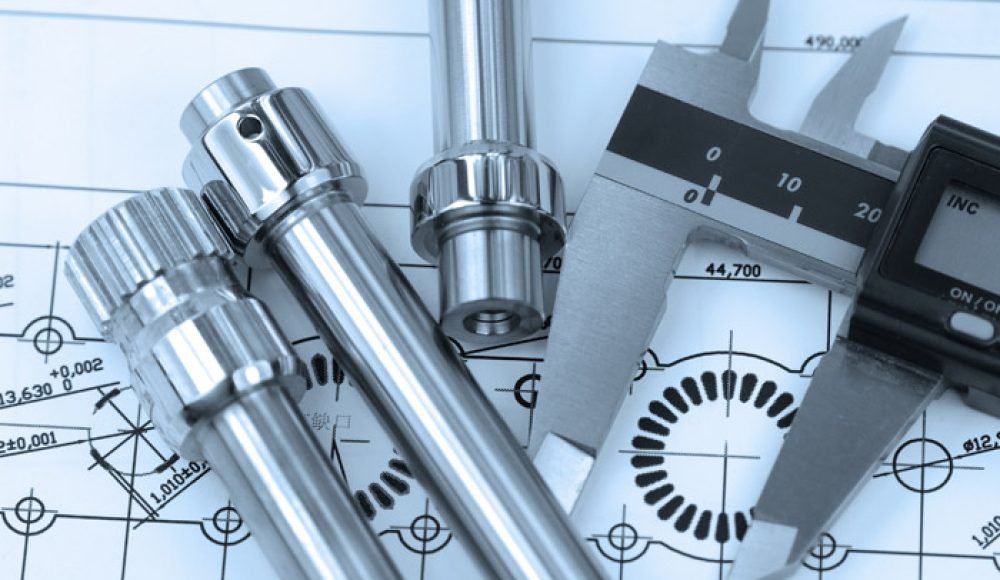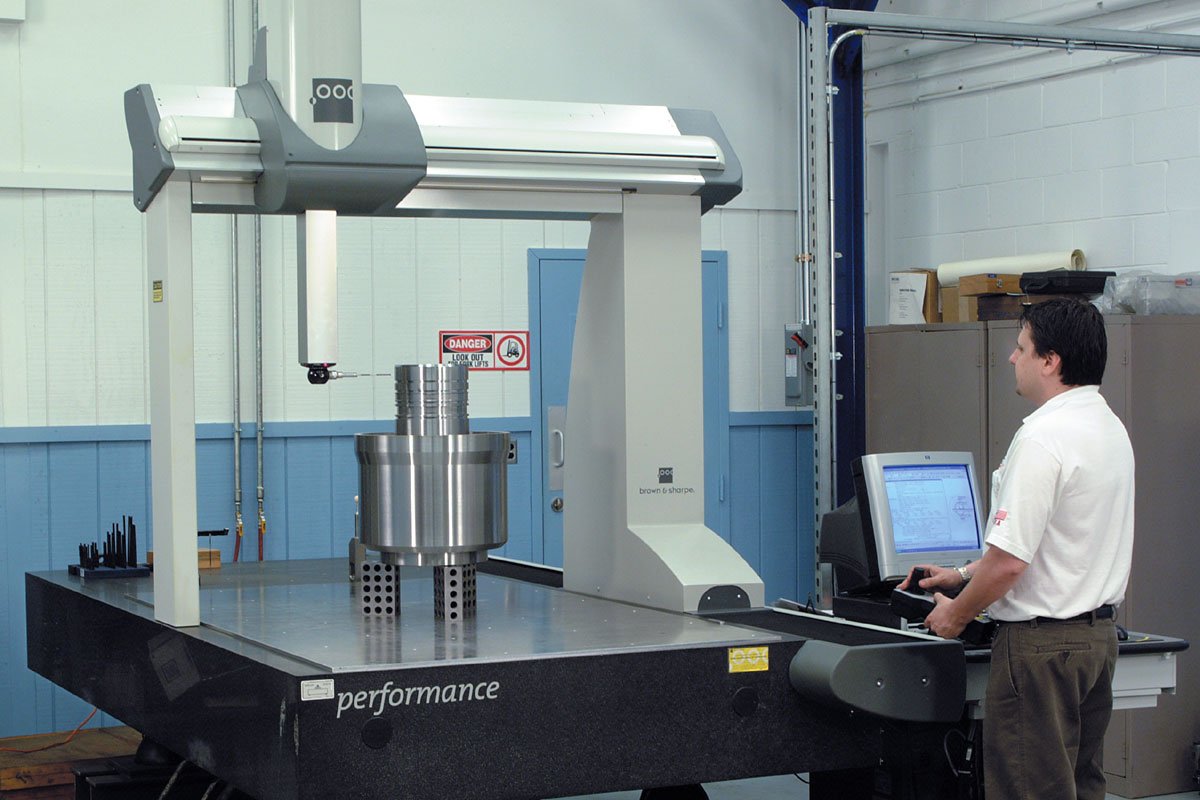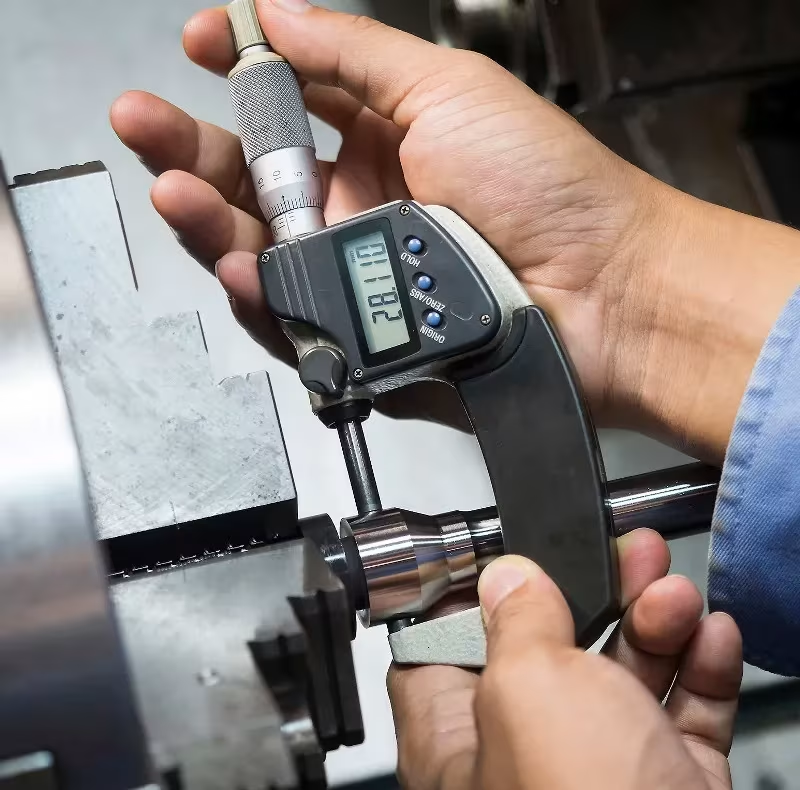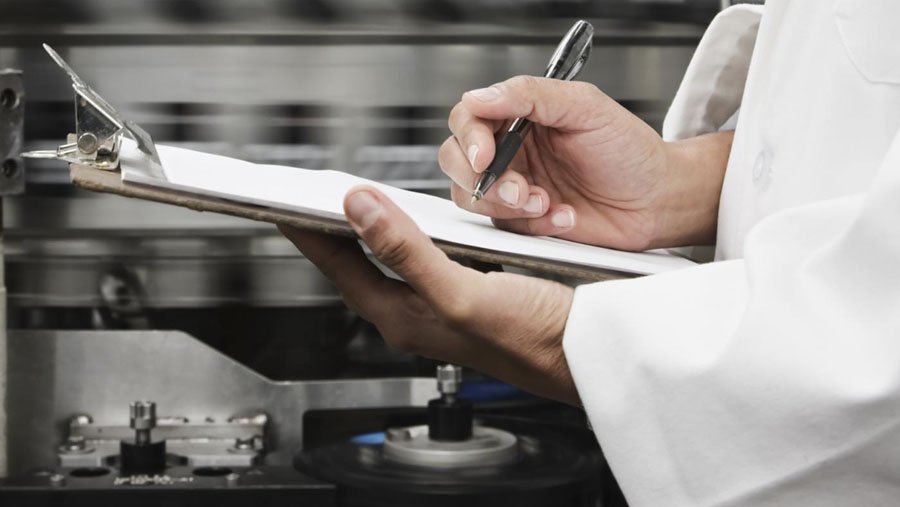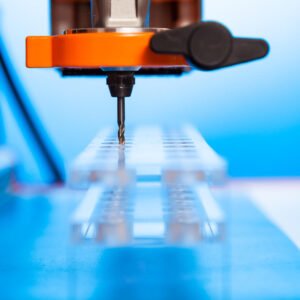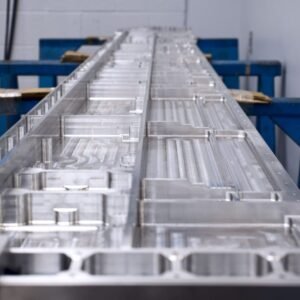Тестване на качеството и проверка играят решаваща роля в CNC обработка, пряко влияе на надеждността на продукта, функционалност, и удовлетвореност на клиентите. Разбиране на инструментите, техники, и участващите етапи на проверка гарантират постоянно висококачествена продукция. Тази статия предлага подробно ръководство за практиките за тестване на качеството на обработката на ЦПУ.
В прецизно производство, особено CNC обработка, Поддържането на изключително качество не е договарящо. Всяка част трябва да отговаря на строги спецификации, Осигуряване на надеждност и производителност. Изчерпателно тестване и проверка формират основата на управлението на качеството, Помощ на производителите да произвеждат безупречни компоненти последователно.
Какво е тестване и проверка на качеството в обработката на ЦПУ?
Тестване на качеството и проверка включват изследване на обработените компоненти, за да се провери тяхното съответствие с определени критерии - като размери, допустими отклонения, свойства на материала, и качество на повърхността. Целта е да се открият и премахнат дефектите, преди продуктът да достигне до крайния потребител, Осигуряване на оптимална функционалност и надеждност.
Контрол на качеството срещу. Проверка на качеството срещу. Гарантиране на качеството
Контрол на качеството (Qc): Уверете се, че всичко върви правилно
Контролът на качеството означава дейностите, които правите по време на производството, за да поддържате качеството последователно. Става въпрос за проверка на процеса, Намиране на проблеми рано, и ги поправяте бързо - така че нямате дефекти по -късно. Помислете за QC като следване на рецепта внимателно всеки път, когато готвите, Уверете се, че всяко ястие има вкус също толкова добър, колкото последното.
Проверка на качеството: Проверка на готовия продукт
Проверката на качеството включва внимателно изследване на готовите части или материали, за да се увери, че те съответстват на необходимите спецификации. Тази стъпка се фокусира върху измервателните размери, Проверка на повърхности, и визуално търси някакви недостатъци или дефекти. Представете си, че инспектирате плодовете на пазара - вдигате всяко парче и се уверете, че е узрял, небран, И достатъчно добър за закупуване.
Гарантиране на качеството (Qa): Планиране за предотвратяване на проблеми
Осигуряването на качеството е свързано с планирането и подобряването на процесите, така че проблемите да не се случват на първо място. Тя включва създаване на насоки, Задаване на стандарти, и обучение на служители. QA помага на всички да знаят точно как да си вършат работата правилно, Осигуряване на крайните продукти отговаря на стандартите за качество последователно. Това е като практикуване на добра хигиена, за да останете здрави, а не просто да лекувате заболявания, след като се случат.
Основни параметри за контрол на качеството в обработката на ЦПУ
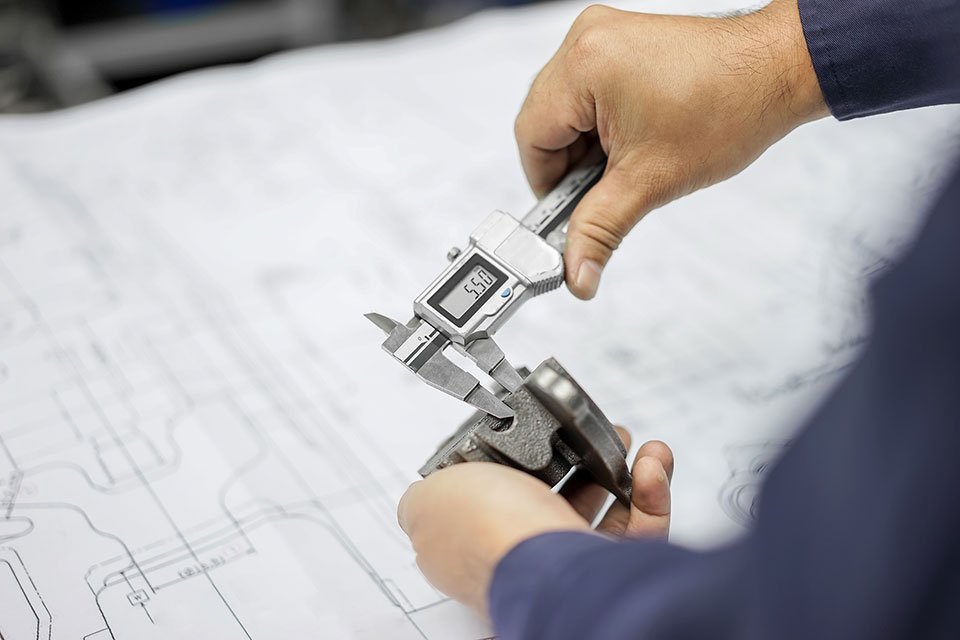
Проверка на инженерни проверки Проверка на размерите Автомобилни части Референтен чертеж от Vernier Caliper в индустриална фабрика
Размерена точност и толерантност
Размерът прецизността е от решаващо значение за ефективността на части и годни. Висококачествената обработка изисква точно придържане към определени допустими отклонения.
Повърхностно покритие и грапавост
Качественият повърхностен завършек влияе върху естетическата привлекателност на частта и функционалната ефективност, намаляване на триенето и износването.
Материална твърдост и здравина
Правилната твърдост и здравина на материала гарантират, че компонентите издържат на предвидените оперативни напрежения.
Геометрично толеринг (GD&Т)
Осигурява точна форма, позиция, и ориентация на обработени характеристики, Критичен за сглобяването и производителността.
Контрол на процеса на обработка
Корекции в реално време и статистически методи поддържат последователни параметри на обработка (скорост, фураж, и инструментална екипировка).
Носене на инструменти и живот
Условието на инструмента за мониторинг предотвратява влошаването на точността на размерите и повърхностното покритие.
Сглобяване и приспособяване
Прецизни размери на части осигуряват безпроблемно сглобяване без допълнителни модификации.
Фактори на околната среда
Контролираната температура и влажност са от съществено значение за поддържането на стабилността на размерите.
Спазване на стандартите и разпоредбите
Среща с качествени показатели като ISO 9001 (Общо производство) и AS9100 (аерокосмически специфични) осигурява постоянно осигуряване на качеството.
Основни техники и инструменти за контрол на качеството
Инструменти за измерване на размери
Калиперс и микрометри: Точни измервания за дължина, диаметър, и дебелина.
Координатна измервателна машина (CMM): Сложна размерена проверка за сложни геометрии.
Габаритни блокове и измервания на нишки: Проверка на точността на стандартизация и точност на нишката.
Тестери за грапавост на повърхността
Профилометри: Подробно измерване на грапавостта на повърхността.
Оптични сравнители: Визуална проверка на подробни повърхностни характеристики.
Оборудване за тестване на твърдост
Тестери за твърдост на Рокуел: Често срещан метод за метали.
Тестери за твърдост на Бринел: Подходящ за по -меки метали и сплави.
Неразрушително тестване (Ndt)
Ултразвуково тестване: Открива вътрешни недостатъци със звукови вълни.
Рентгенова проверка: Идентифицира вътрешните дефекти и материалните несъответствия.
Проверка на магнитни частици: Откриване на дефекти на повърхността и под-повърхността във черни материали.
Статистически контрол на процесите (SPC) Софтуер
Мониторинг в реално време и статистически анализ гарантират последователност и надеждност.
Мониторинг на състоянието на инструмента
Устройства и автоматизирани системи за проследяване на инструменти, предотвратяване на неочаквани провали.
Оборудване за мониторинг на околната среда
Сензорите за температура и влажност поддържат условията на обработка за прецизна стабилност.
Геометрично оразмеряване и толеранс (GD&Т) Инструменти
Измервателни уреди и тела проверяват формуляра, ориентация, и точност на позицията.
Инструменти за визуална проверка
Увеличаващи устройства, микроскопи, и борескопите улесняват подробен визуален анализ.
Оборудване за анализ на материали
Спектрометри: Проверете елементарния състав.
Анализ на микроструктурата: Оценява структурите на зърното и целостта на материала.
Инструменти за тестване на сглобяване и приспособяване
Go/No-Go Gaugues: Бързи размери проверки.
Функционални тестови платформи: Валидирайте ефективността при реалистични работни условия.
Системи за документация и проследяване
Софтуерът проследява данните за проверка, Осигуряване на прозрачност и съответствие.
Етапи на тестване и проверка на обработването на качеството
Инспекция на суровини
Проверка на свойствата на материала преди производството, за да се гарантира спазването на съответствието.
Първа проверка на статията (Фай)
Подробна проверка на първия компонент, произведен за потвърждаване на първоначалното придържане на качеството.
Инспекция в процеса
Редовни проверки по време на обработка за незабавно идентифициране на дефекти и предотвратяване на скъпа преработка.
Размерна проверка
Внимателна проверка на размерите на части, като се използват калибрирани измервателни инструменти.
Инспекция на повърхностното покритие
Анализ на качеството на повърхността, за да се гарантира спазването на функционалните и естетическите изисквания.
Визуална проверка
Идентифициране на видими несъвършенства, драскотини, и дефекти, които могат да повлияят на използваемостта на частта.
Неразрушително тестване (Ndt)
Проверка за вътрешни недостатъци, без да навреди на части, От съществено значение за приложенията с висок риск.
Тестване на твърдост
Осигуряване на материална твърдост отговаря на определените изисквания за механично свойство.
Функционално тестване
Потвърждавайки, че частите се представят по предназначение в реалистични експлоатационни сценарии.
Инспекция на монтаж и монтиране
Валидиране на правилния сглобяване и правилното прилягане на компонентите.
Окончателна проверка
Изчерпателен преглед на готовите части, за да се гарантира пълното спазване на спецификациите на качеството.
Статистически контрол на процесите (SPC)
Текущо наблюдение на производствените процеси, използващи статистически методи.
Документация и водене на записи
Изчерпателното управление на записите гарантира отчетността и улеснява подобренията на качеството.
Лечение след обработване
Проверка на резултатите от вторични процеси като топлинна обработка или покритие.
Проверка на опаковки и доставка
Гарантирането на готовите части остават без щети по време на транспортиране и доставка.
Значение на обучението на персонала
Квалифицираният персонал е от решаващо значение за качеството на обработката. Редовното обучение гарантира, че операторите разбират и ефективно прилагат най -новите методи и стандарти за контрол на качеството. Обучителни корици:
Правилно използване на измервателни инструменти.
Тълкуване на спецификации и допустими отклонения.
Прилагане на практиките за осигуряване на качеството.
Проверка на качеството и осигуряване на топи прецизност
С върхова прецизност, Осигуряването на качеството е неразделна част от нашите операции. Ние разгръщаме най-съвременното оборудване за проверка, включително:
Тестер за рентгенови материали: Бързото идентифициране на материалите осигурява точност в прототипа и производството.
Системи за инспекция на машина: Регулиране в реално време към параметрите на обработка.
Оптични проектори: Прецизни геометрични измервания.
Координирани измервателни машини (Cmms): Разширена геометрична и размерена проверка.
Нашият процес интегрира задълбочени проверки от приемане на материали чрез валидиране на крайния продукт, гарантиране на високи постижения на всяка стъпка.
Заключение
Постигане и поддържане Висококачествени части от CNC, обработени с ЦПУ Изисква усърдно прилагане на стабилни техники за проверка, квалифициран персонал, и усъвършенствано оборудване. Чрез разбиране на тези практики и непрекъснато подобряване на тях, Производителите могат надеждно да произвеждат прецизни компоненти, Насърчаване на доверието на клиентите и репутацията на индустрията.
Често задавани въпроси
Q1: Защо точността на размерите е критична при обработката на ЦПУ?
Точността на размерите гарантира правилно приспособяване и функциониране, Избягване на проблеми с сглобяването и функционални повреди.
Q2: Как повърхностният завършек влияе на производителността на компонента?
Повърхностният завършек влияе върху естетиката, триене, устойчивост на износване, и живот от умора.
Q3: Какво е неразрушително тестване (Ndt)?
NDT методите откриват вътрешни или външни дефекти, без да повредят компонента, от съществено значение за критичните за безопасността индустрии.
Q4: Защо спазването на ISO и аерокосмическите стандарти е важно?
Посрещането на тези стандарти гарантира, че частите отговарят на универсално признатите критерии за качество и безопасност.
Q5: Колко често трябва да се извършва инспекция по време на обработката?
Редовни проверки трябва да се извършват на критични етапи, включително първоначална проверка на материала, първа проверка на артикула, Мониторинг на процеса, и окончателно валидиране.
Прочетете повече:
Защо да изберете персонализирана услуга за CNC обработка
Повърхностни облицовки за обработка на ЦПУ

